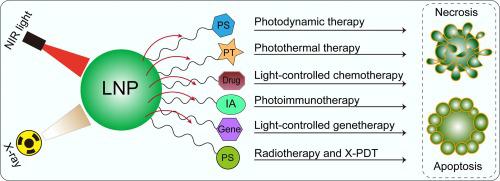当前位置:
X-MOL 学术
›
Coord. Chem. Rev.
›
论文详情
Our official English website, www.x-mol.net, welcomes your feedback! (Note: you will need to create a separate account there.)
Lanthanide-based nanoparticles for cancer phototherapy
Coordination Chemistry Reviews ( IF 20.6 ) Pub Date : 2024-03-14 , DOI: 10.1016/j.ccr.2024.215773 Zichao Luo , Duo Mao , Xinchao Li , Jing Luo , Changyang Gong , Xiaogang Liu
Coordination Chemistry Reviews ( IF 20.6 ) Pub Date : 2024-03-14 , DOI: 10.1016/j.ccr.2024.215773 Zichao Luo , Duo Mao , Xinchao Li , Jing Luo , Changyang Gong , Xiaogang Liu

|
Phototherapy, using light as a therapeutic modality, has been widely applied in treating various diseases, especially cancer. This approach is valued for its non-invasive nature and minimal risk of drug resistance. However, phototherapy faces challenges such as the undesired delivery of phototherapeutic agents, potential phototoxicity, and limited penetration of light into tissues. Lanthanide-doped nanoparticles offer attractive opportunities to improve the therapeutic efficacy of photodynamic therapy. These nanoparticles are distinguished by their unique optical properties, such as excellent photostability against blinking and bleaching effects, large Stokes or anti-Stokes shifts, sharp emission peaks, and long luminescence lifetimes. In addition, lanthanide-doped nanoparticles can be excited by near-infrared (NIR) light or X-rays, enabling deep-tissue penetration. Beyond the use of photosensitizers, nanoparticle surfaces can be easily modified with targeting ligands, chemical drugs, or functional molecules to enhance the effectiveness of phototherapy or to enable combination therapy. In this review, we organize the use of lanthanide-based nanoparticles in tumor phototherapy into six main domains: photodynamic therapy, photothermal therapy, X-ray-based therapy, light-controlled therapy, photoimmunotherapy, and other innovative treatments that can be regulated by light. We introduce the basic principles of phototherapy and the characteristics of lanthanide nanoparticles. Following this, we summarize the latest advances in utilizing lanthanide-based nanoparticles for tumor phototherapy, focusing on their design principles, mechanisms of action, and effectiveness in cancer treatment. To conclude, we address the existing challenges and explore future opportunities within this area of research.
中文翻译:

用于癌症光疗的镧系纳米粒子
光疗法,利用光作为治疗方式,已广泛应用于治疗各种疾病,特别是癌症。这种方法因其非侵入性和耐药性风险最小而受到重视。然而,光疗法面临着一些挑战,例如光治疗剂的意外递送、潜在的光毒性以及光进入组织的穿透性有限。稀土掺杂纳米粒子为提高光动力疗法的治疗效果提供了诱人的机会。这些纳米粒子以其独特的光学特性而著称,例如针对眨眼和漂白效应的优异光稳定性、大斯托克斯或反斯托克斯位移、尖锐的发射峰和长发光寿命。此外,镧系元素掺杂纳米粒子可以被近红外(NIR)光或X射线激发,从而实现深层组织穿透。除了使用光敏剂之外,纳米颗粒表面还可以很容易地用靶向配体、化学药物或功能分子进行修饰,以增强光疗的有效性或实现联合治疗。在这篇综述中,我们将基于镧系元素的纳米颗粒在肿瘤光疗中的使用分为六个主要领域:光动力疗法、光热疗法、基于X射线的疗法、光控疗法、光免疫疗法以及其他可以通过调节的创新疗法。光。我们介绍了光疗的基本原理和稀土纳米粒子的特性。接下来,我们总结了利用镧系纳米粒子进行肿瘤光疗的最新进展,重点关注其设计原理、作用机制以及在癌症治疗中的有效性。总之,我们解决了该研究领域中现有的挑战并探索了未来的机遇。
更新日期:2024-03-14
中文翻译:

用于癌症光疗的镧系纳米粒子
光疗法,利用光作为治疗方式,已广泛应用于治疗各种疾病,特别是癌症。这种方法因其非侵入性和耐药性风险最小而受到重视。然而,光疗法面临着一些挑战,例如光治疗剂的意外递送、潜在的光毒性以及光进入组织的穿透性有限。稀土掺杂纳米粒子为提高光动力疗法的治疗效果提供了诱人的机会。这些纳米粒子以其独特的光学特性而著称,例如针对眨眼和漂白效应的优异光稳定性、大斯托克斯或反斯托克斯位移、尖锐的发射峰和长发光寿命。此外,镧系元素掺杂纳米粒子可以被近红外(NIR)光或X射线激发,从而实现深层组织穿透。除了使用光敏剂之外,纳米颗粒表面还可以很容易地用靶向配体、化学药物或功能分子进行修饰,以增强光疗的有效性或实现联合治疗。在这篇综述中,我们将基于镧系元素的纳米颗粒在肿瘤光疗中的使用分为六个主要领域:光动力疗法、光热疗法、基于X射线的疗法、光控疗法、光免疫疗法以及其他可以通过调节的创新疗法。光。我们介绍了光疗的基本原理和稀土纳米粒子的特性。接下来,我们总结了利用镧系纳米粒子进行肿瘤光疗的最新进展,重点关注其设计原理、作用机制以及在癌症治疗中的有效性。总之,我们解决了该研究领域中现有的挑战并探索了未来的机遇。



























 京公网安备 11010802027423号
京公网安备 11010802027423号